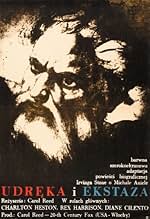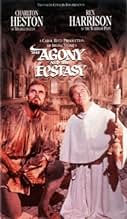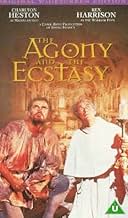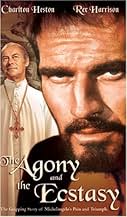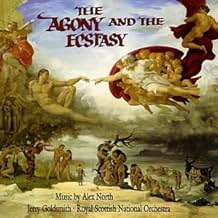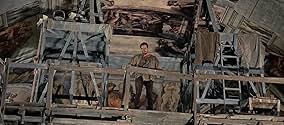IMDb RATING
7.2/10
8.3K
YOUR RATING
The biographical story of Michelangelo's troubles while painting the Sistine Chapel at the urging of Pope Julius II.The biographical story of Michelangelo's troubles while painting the Sistine Chapel at the urging of Pope Julius II.The biographical story of Michelangelo's troubles while painting the Sistine Chapel at the urging of Pope Julius II.
- Nominated for 5 Oscars
- 3 wins & 9 nominations total
Fortunato Arena
- Pope's Bodyguard
- (uncredited)
Lars Bloch
- Baron Von Silenen
- (uncredited)
Angelo Boscariol
- Papal Guard
- (uncredited)
Calisto Calisti
- Physician
- (uncredited)
Amerigo Castrighella
- Quarry cart assistant
- (uncredited)
Anita Ceccotti
- Woman Under the Chapel
- (uncredited)
Enrico Chiappafreddo
- Tavern Customer
- (uncredited)
- Director
- Writers
- All cast & crew
- Production, box office & more at IMDbPro
Storyline
Did you know
- TriviaIn his 1995 autobiography "In the Arena" Charlton Heston denied that Michelangelo Buonarroti was a homosexual. He also refused permission to use scenes from "The Agony and the Ecstasy" in the 1995 documentary "The Celluloid Closet" because he told the filmmakers he had done a lot of research for his role and could assure them that Michelangelo was not gay.
- GoofsAs shown in the movie, Michelangelo created a flat wooden platform on brackets built out from holes in the wall, high up near the top of the windows. But contrary to what is depicted in the film, he did not lie on this scaffolding while he painted, but painted from a standing position.
- ConnectionsEdited from Prologue: The Artist Who Did Not Want to Paint (1965)
Featured review
"The Agony and the Ecstasy" is the story of Michaelangelo and his painting of the Sistine Chapel at the behest of Pope Julius II, a warrior and Patron of the Arts.
But it's really about so much more - the connection between art and the artist, faith, will, and the quest for perfection. Most of all, it's about the complicated relationship of two determined men, Michaelangelo and Pope Julius, which is adversarial and even violent.
The color and scenery in this film are truly beautiful, but I'd love to see a restored print, as I imagine the colors would even be richer.
Charlton Heston is a convincing and strong Michelangelo in what may be his best performance. It's buoyed by the magnificent work of Rex Harrison as Julius II. The two spark one another, and the result is an exciting screen teaming. There is hatred, resentment, a battle of wills, love and admiration between them, the agony and ecstasy of connecting with another, as Diane Cilento says in the film. She plays a woman in love with Michaelangelo. He explains that he cannot love her because of the commitment he has made to his true love, his art. The book hints at Michaelangelo's homosexuality, and it's covered with one line. After Michaelangelo says that he cannot match her feelings, he looks at a sketch of a nude man. "And it's not that either," he says.
Many scenes stick out. The somewhat hokey one in the mountains, when Michaelangelo looks at the heavens and receives his inspiration is nevertheless a gorgeous scene; the incredible scene when Michaelangelo discovers the Pope alone at night with a candle studying the ceiling is perhaps the best, as Michaelangelo explains his concept of God and faith. And the last scene between the two men is unforgettable.
There is a documentary about Michaelangelo and his work before the movie begins. A magnificent film. Don't miss it.
But it's really about so much more - the connection between art and the artist, faith, will, and the quest for perfection. Most of all, it's about the complicated relationship of two determined men, Michaelangelo and Pope Julius, which is adversarial and even violent.
The color and scenery in this film are truly beautiful, but I'd love to see a restored print, as I imagine the colors would even be richer.
Charlton Heston is a convincing and strong Michelangelo in what may be his best performance. It's buoyed by the magnificent work of Rex Harrison as Julius II. The two spark one another, and the result is an exciting screen teaming. There is hatred, resentment, a battle of wills, love and admiration between them, the agony and ecstasy of connecting with another, as Diane Cilento says in the film. She plays a woman in love with Michaelangelo. He explains that he cannot love her because of the commitment he has made to his true love, his art. The book hints at Michaelangelo's homosexuality, and it's covered with one line. After Michaelangelo says that he cannot match her feelings, he looks at a sketch of a nude man. "And it's not that either," he says.
Many scenes stick out. The somewhat hokey one in the mountains, when Michaelangelo looks at the heavens and receives his inspiration is nevertheless a gorgeous scene; the incredible scene when Michaelangelo discovers the Pope alone at night with a candle studying the ceiling is perhaps the best, as Michaelangelo explains his concept of God and faith. And the last scene between the two men is unforgettable.
There is a documentary about Michaelangelo and his work before the movie begins. A magnificent film. Don't miss it.
- How long is The Agony and the Ecstasy?Powered by Alexa
Details
- Release date
- Country of origin
- Languages
- Also known as
- Irving Stone's The Agony and the Ecstasy
- Filming locations
- Production company
- See more company credits at IMDbPro
Box office
- Budget
- $10,000,000 (estimated)
- Runtime2 hours 18 minutes
- Color
- Aspect ratio
- 2.20 : 1
Contribute to this page
Suggest an edit or add missing content



